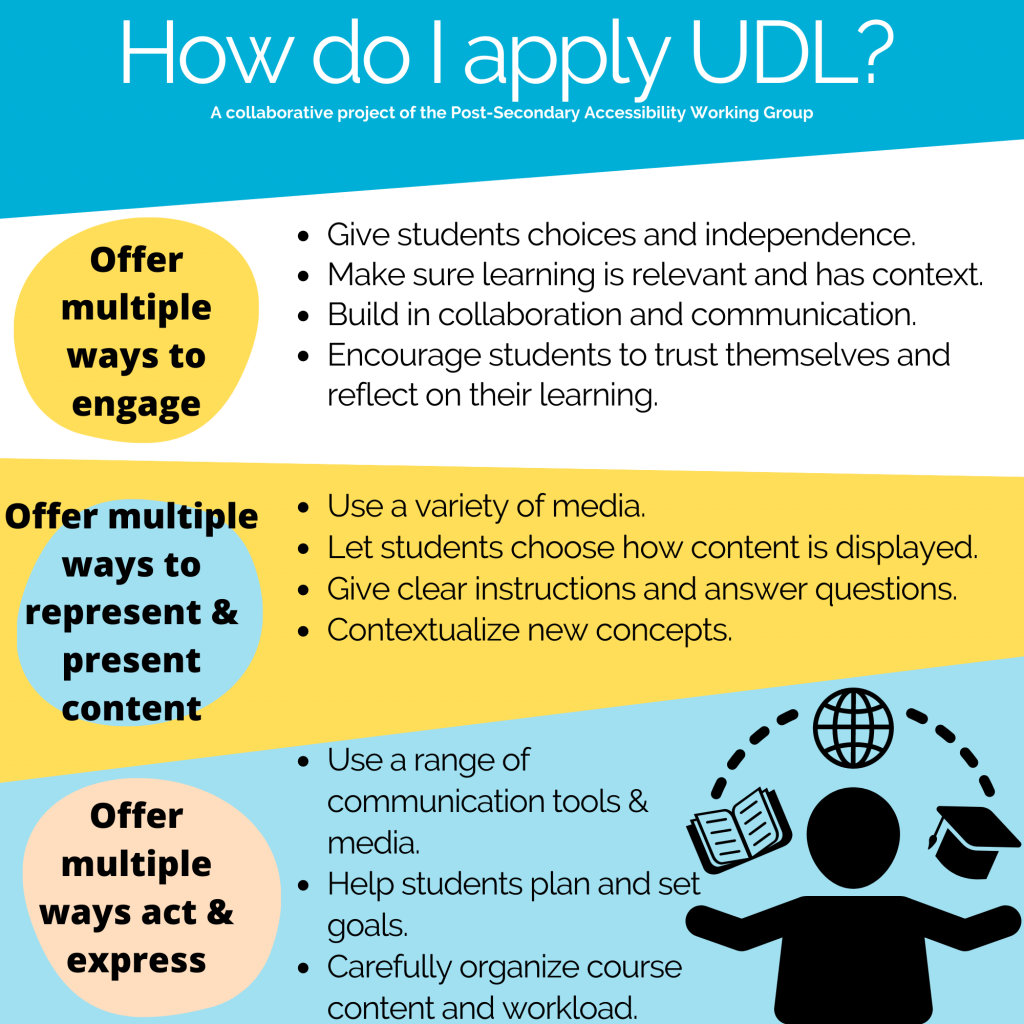3 Inclusion for all: Universal Design for Learning
Origin of UDL
Universal Design for Learning (UDL) began in 1984 when Dr. David Rose and Dr. Ann Meyer, two researchers from the Harvard School of Graduate Education, incorporated CAST – The Center for Applied Specialized Technology. The goal of CAST was to revolutionize the way that students with special needs were taught by introducing technology that would allow teachers and students to customize their learning experiences. By 1990, this goal evolved to address the “disabilities of schools” instead of the “disabilities of the individual”. This change mirrored what was happening in architecture, with buildings designed so that all people could access them regardless of their disabilities. [1]
In the 1990s CAST introduced universal design for learning (UDL), a framework to improve teaching and learning and help educators improve and optimize learning experiences for all individuals.[2]
Introduction
Universal Design for Learning (UDL) is about changing the design of course content and the learning environment — NOT changing the learner.
UDL improves and optimizes teaching and learning and helps give ALL students an equal opportunity to succeed. UDL is an evidence-based educational framework based on research in the learning sciences.
UDL is broadly focused on reducing barriers to learning — for everyone! — by making sure that instructional materials (texts, images, audio) and classroom environments, support services, and activities are accessible to as many learners, instructors, and staff as possible.
For example, using video with captions helps people with hearing loss as well as students who speak English as an additional language or have difficulty with auditory processing. It can also help reinforce students’ understanding.
The three central principles of UDL are:
- Provide multiple means of engagement. Develop learning options to produce and sustain interest.
- Provide multiple means of representation. Provide content in multiple ways.
- Provide multiple means of action and expression. Offer options that allow students to fully demonstrate knowledge.
CAST ‘s UDL Guidelines are a tool used in the implementation of UDL in classrooms and learning environments.
The benefits of UDL[3]
Though students with identified disabilities and learning differences might feel the benefits of universal design most, UDL works for both learners and educators.
- UDL reduces the need for, and time required to implement individual accommodations.
- UDL supports a diverse range of students with concrete strategies to improve learning.
- UDL gives students more options and opportunities to show their knowledge.
- UDL helps students become more self-aware and knowledgeable.
- UDL helps maintain high academic rigor and expectations.
UDL is essential for some and helpful for all
The students you encounter face many systemic, structural, and institutional inequities. UDL anticipates learner variability and accessibility. Traditional educational settings usually privilege certain types of learners: able-bodied, neurotypical, fluent in the language of instruction, good at learning course content by reading textbooks or listening to lectures, and good at test-taking.
UDL principles[4] allow educators to meet diverse student needs, including:
- flexible ways for students to access material and demonstrate their learning
- flexible options to make learning relevant to all students
- flexible learning environments and spaces that leverage the strengths of individuals
- multiple means of representation, expression, and engagement that tap into learners’ unique abilities, strengths, and interests
The goal of UDL is to support students to become “expert learners” who are purposeful and motivated, resourceful, and knowledgeable, strategic and goal driven.
How do I apply UDL? [5]

Adapted from: Mohawk College (n.d.). Universal Design for Learning Information for Educators, Benefits of Universal Design for Learners. Retrieved from https://www.mohawkcollege.ca/employees/centre-for-teaching-learning/universal-design-for-learning/universal-design-for-learning
Is UDL going to make my teaching completely inclusive and accessible?
No! UDL alone will not make your courses completely inclusive and accessible, but it does offer a clear, useful, and evidence-based framework for making your teaching more effective for more students. Integrating UDL with other equity-centred practices, like individual academic accommodations and culturally responsive pedagogy (CRP), will build a foundation for belonging for all students.
LEARN MORE:
Complete the Universal Design for Learning Module of the Transforming Practice: Learning Equity, Learning Excellence Curriculum.[6]
This free professional development opportunity for faculty and student services professionals in higher education in Nova Scotia. This open courseware consists of 10 self-paced modules that provide the tools and resources needed to foster inclusive, equity-centred learning environments that celebrate, recognize, adapt to, and accommodate diverse learning needs.
The Ontario Universal Design for Learning (UDL) for Inclusivity, Diversity, Equity, and Accessibility (IDEA) [7]resource references Ontario legislation, but is broadly applicable. This open courseware aims to provide educators with an introduction to UDL, considerations for equity, diversity and inclusion in educational settings, and Indigenous pedagogies and their relationship to UDL.
IDEA includes the following six learning modules:
- Introduction and Overview of UDL
- UDL in Post-Secondary and Technology-Enabled Learning Environments
- Legislative Requirements under the AODA and OHRC
- Equity, Diversity, and Inclusion (EDI)
- Indigenous Pedagogies and the Benefits for All Learners in Ontario
- UDL for AODA, EDI and Indigenous Pedagogies in Post-Secondary Learning Environments
- Thibodeau, T. (2021, June 6). The science and research behind the UDL framework [blogpost]. Novak Education. https://www.novakeducation.com/blog/the-science-and-research-behind-the-udl-framework] ↵
- Meyer, A., Rose, D.H., & Gordon, D. (2014). Universal design for learning: Theory and practice. CAST. https://www.cast.org/impact/universal-design-for-learning-udl ↵
- Adapted from Universal Design for Learning (UDL) for Inclusion, Diversity, Equity, and Accessibility (IDEA) edited by Darla Benton Kerney, published by eCampus Ontario, shared under a CC BY 4.0 license. ↵
- CAST (2018). Universal Design for Learning Guidelines version 2.2. Retrieved from http://udlguidelines.cast.org ↵
- Mohawk College (n.d.). Universal Design for Learning Information for Educators, Benefits of Universal Design for Learners. Retrieved from https://www.mohawkcollege.ca/employees/centre-for-teaching-learning/universal-design-for-learning/universal-design-for-learning ↵
- Social Equity Working Group Curriculum Committee (2022). Transforming Practice: Learning Equity, Learning Excellence. CC BY-NC-SA. https://caul-cbua.pressbooks.pub/transformingpractice/ ↵
- Darla Benton Kearney (2022). Universal Design for Learning (UDL) for Inclusion, Diversity, Equity, and Accessibility (IDEA). CC BY-NC-SA. https://ecampusontario.pressbooks.pub/universaldesign/ ↵

